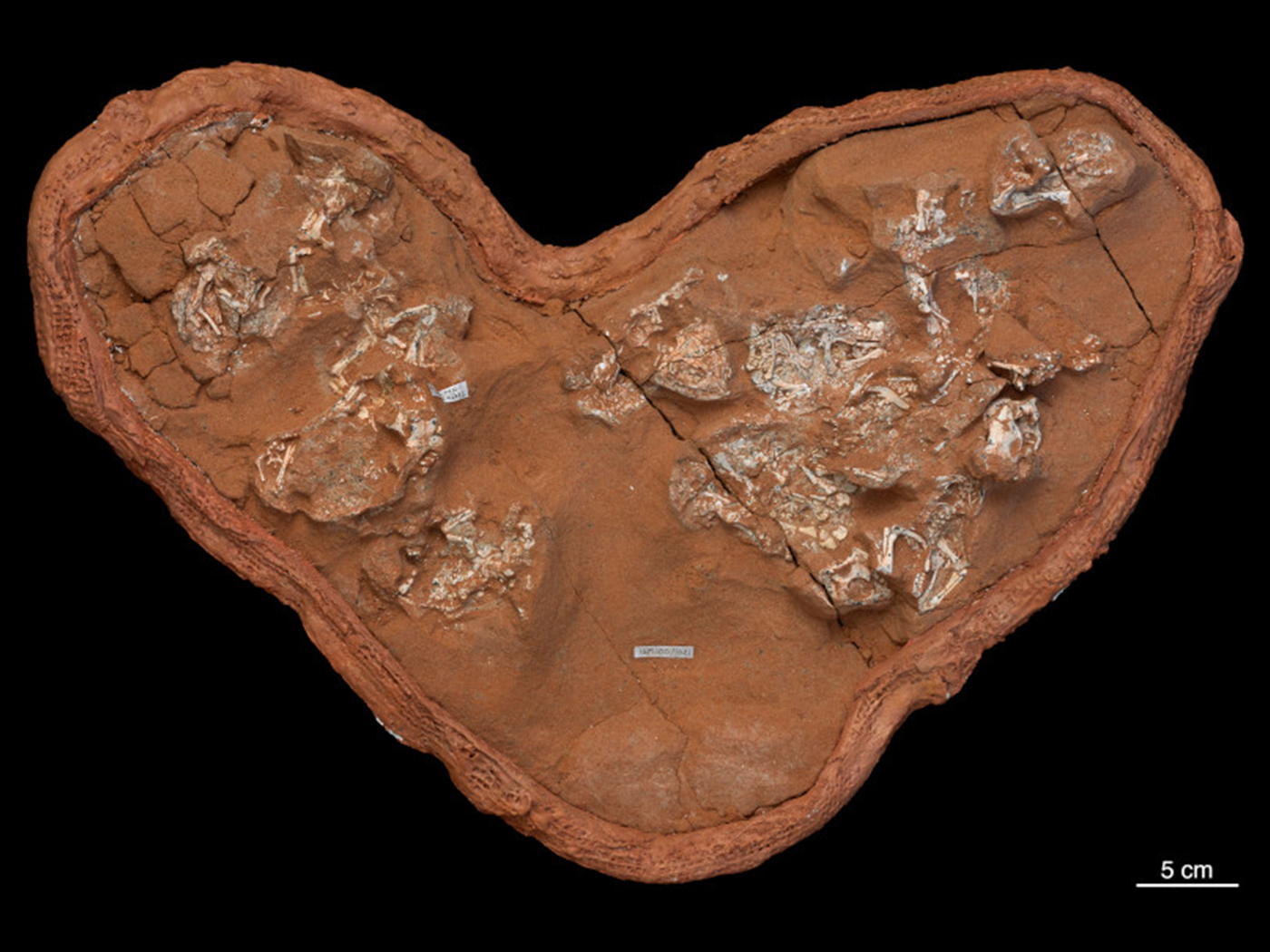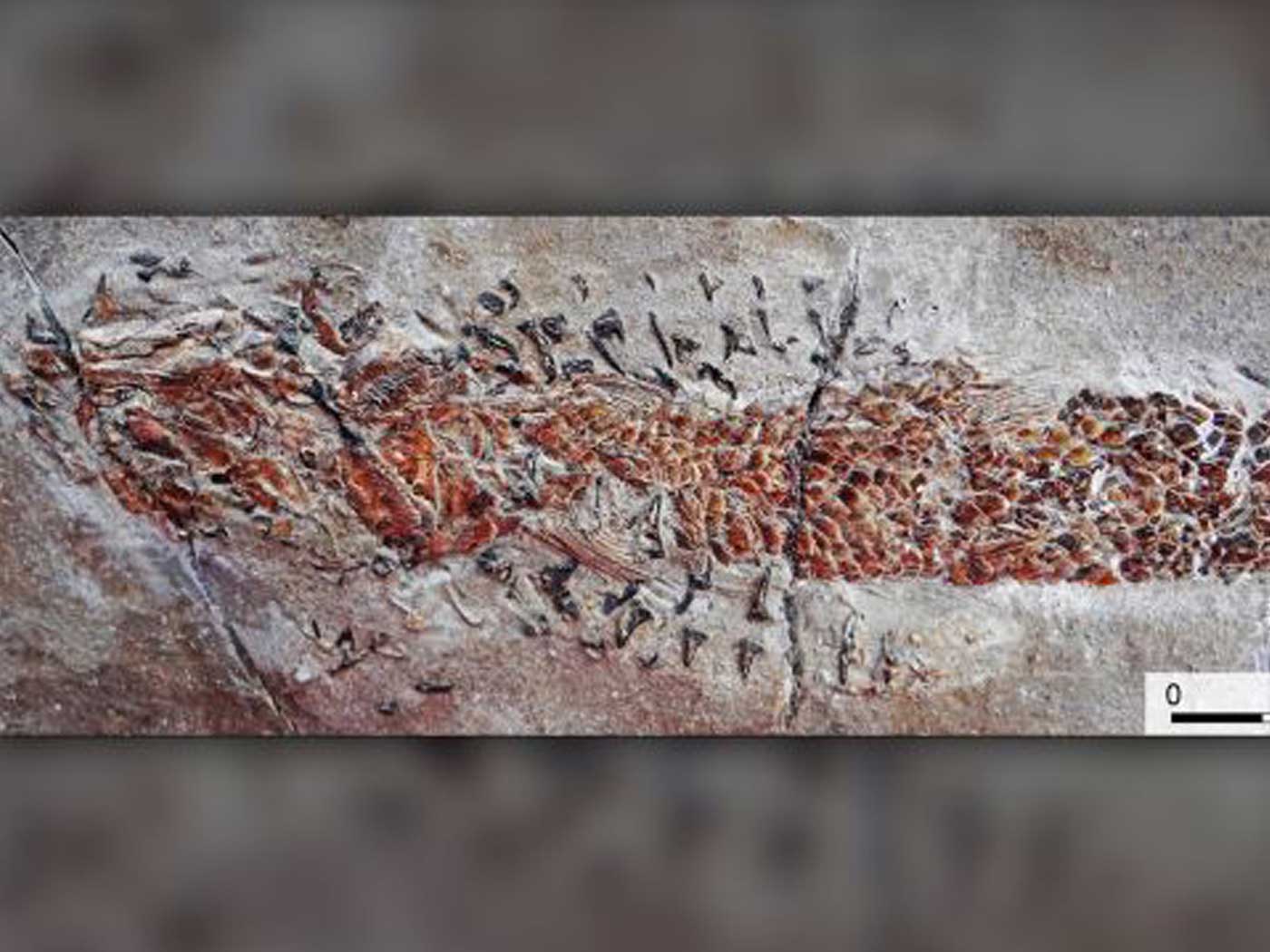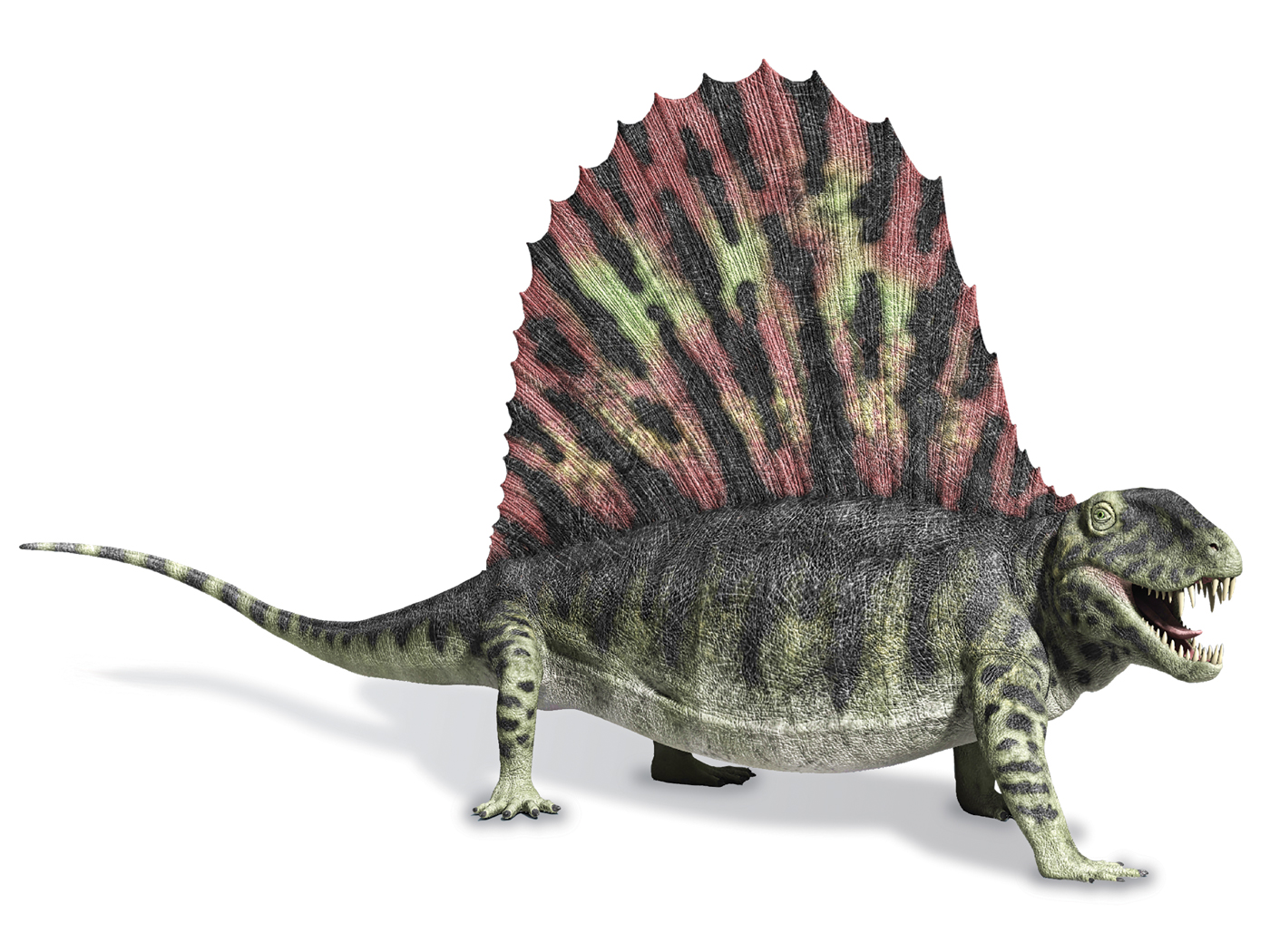The term "Dinosauria" was first used in 1841 by Sir Richard Owen in an address to the British Association for the Advancement of Science, subsequently publishing the term in 1842. He was the first to recognize that dinosaurs ("fearfully great reptiles") were a distinct group of reptiles, much different from today's lizards. Owen defined dinosaurs as reptiles that walked erect, having a posture similar to elephants and rhinos. Dinosaurs did not have wings, flippers, or fins. Owen was the best known and most authoritative comparative anatomist in the nineteenth century. He argued extensively against Darwin's theory of evolution later in his life.
Thomas Huxley, the famous supporter of Darwin's theory, was the first person to suggest the dinosaurian origin for birds in publications between 1868 and 1870. Huxley found that some dinosaurs had a bird-like ankle joint, a short torso, massively braced hips, a long and mobile neck, and long hind limbs so typical of bird anatomy. He also found that some dinosaurs had holes in the bones for air sacs as in modern birds, and that some dinosaurs possessed the backward pubic bone typical of birds.1 Later, the presence of what is interpreted as a "wishbone" in some dinosaurs was added to this list.2
Archaeopteryx to Archaeoraptor: Bird to Hoax
In the middle of the controversy is the so-called transitional fossil often cited as the link between birds and dinosaurs entitled Archaeopteryx. All ten specimens have been found in Germany in the Solnhofen Limestone of Late Jurassic age (150 million years old by evolutionary standards). Pat Shipman stated that, "These few, special fossils have served as the basis for brilliant deductions, wild speculations, penetrating analyses, and amazing insights."3 It is the well-preserved impressions of feathers on several of the specimens that have elevated Archaeopteryx to icon status as the first bird.
Among the first critics of Archaeopteryx as the first bird was Sankar Chatterjee when he announced the discovery of a Triassic "bird" he called Protoavis. As sponsors of Chatterjee's research, the National Geographic Society (NGS) chose to release the discovery before formal peer-review and scientific scrutiny of his work, drawing sharp criticism from his colleagues.4 He did however, allow the NGS to publicize his finding, theoretically pushing back the first bird 75 million years before Archaeopteryx. However, many paleontologists did not agree, and today some even doubt Protoavis is a bird at all.5 The NGS continued to create controversy with the 1999 publication of the "feathered" dinosaur Archaeoraptor, again announcing the discovery prior to peer-review. It was later learned that this specimen was a glued together composite of a bird and a dinosaur. In other words, it was a fake. Jonathan Wells went so far as to label the specimen the "Piltdown bird" in memory of the Piltdown man hoax. 6 The NGS should have learned in 1991 not to make "scientific" claims or announce discoveries until the findings are first peer-reviewed for scientific integrity.7
One of the biggest stumbling blocks to the idea that dinosaurs evolved into birds continues to be the lack of fossil support. Shipman commented, "The bipedal ancestor hypothesis, while favored strongly by logic, has little direct evidence from the fossil record to support or refute it."8 The best fossil evidence for a link is the historical confusion between Archaeopteryx and Compsognathus. At least three of the Archaeopteryx specimens were initially misidentified as either a Compsognathus or a pterosaur. Unfortunately, these two animals are found in the same strata, making it difficult to argue that Compsognathus was the ancestor of Archaeopteryx. Advocates for the dinosaur/bird hypothesis are left claiming that something yet unknown was the ancestor to Archaeopteryx. "This may be true, but balancing on a hypothetical ancestor is an even shakier proposition than balancing on one leg while the other moves forward," stated Shipman.9
It gets even more confusing when you consider that most of the dinosaurs claimed to be ancestors to birds are found in rocks much younger than Archaeopteryx. Dinosaurs like Velociraptor and Deinonychus are found in rocks of the Cretaceous Period. These rocks are, by evolutionary standards, 75 million years younger than the Late Jurassic Period rocks containing Archaeopteryx. This information tends to be downplayed by the advocates for the dinosaur/bird relationship who insist that some, as yet, undiscovered ancestor must be the common link to both groups, regardless of the lack of fossil support.
Cladistics: An Attempt to Circumvent the Facts
Paleontologists have tried to get around the fossil "problems" by employing a new system of classifying organisms called cladistics. This system describes organisms on the basis of sister-group relationships between organisms.10 Cladists classify extinct and extant organisms on equal footing without regard to time, and in the process, unknown or missing transitional fossils become conveniently dismissed or eliminated.
The problem with cladistics is the arbitrary choice of what constitutes an evolutionary novelty. An evolutionary novelty is an inherited change from a previous pattern or structure that makes an organism unique.11 Choosing evolutionary novelties creates particular problems for extinct organisms because only morphological features are available for comparison. The choices are made based on expert opinion, or in the words of Henry Gee, "persons qualified to judge the evidence."12 Gee further explained, "The danger for scientists is that they will come to believe the hype, that they are indeed secular priests in possession of the truth with a capital T, the 'truth that can be known'. But such truth is expressly unscientific [falls short]."13 The reason many fell for the Archaeoraptor hoax was their belief in their own hype, regardless of the poor science involved.14 They believed so strongly that birds evolved from dinosaurs that all evidence to the contrary was ignored or brushed aside as unimportant. They became "priests," preaching their own version of "science."
Additional Evidence
Many dinosaur skin imprints have been identified in the last 150 years. These discoveries, like the spectacular discovery of embryonic skin imprints from Argentina in 1998, show only scales, very similar to modern reptiles. There are no known dinosaurs possessing feathers like we see in Archaeopteryx.15
Recently, a new dinosaur was discovered, named Juravenator, from rocks near those containing Archaeopteryx.16 This new specimen exhibited clear reptilian scales along its tail without a trace of feathers. The authors attempted to explain the lack of feathers in such a "bird-like" specimen by suggesting that feathers were merely seasonal or that feathers must have evolved more than once. The simplest solution is that they had no feathers in the first place.
Alan Feduccia, an ornithologist, and his team of scientists found no evidence of true feathers in any of the recently published "feathered" dinosaurs from China.17 They concluded that the presumed "protofeathers" were merely the remains of collagenous fiber meshworks that formed feather-looking patterns during decomposition. Feduccia's team further added that it is too early to declare that "birds are living dinosaurs," and that "the problem of avian origins is far from being resolved."18 These authors warned that the strict overemphasis on cladistics, and the ignoring of data from stratigraphy, embryology, ecology, and biogeography, has resulted in misleading interpretations of the evidence.19
Another team of scientists found both soft-tissue and skeletal support that indicates birds and dinosaurs are not related.20 They concluded that the theropod dinosaurs, including the recently discovered, Sinosauropteryx, did not have a bird-type lung-diaphragm, but a crocodilian-type of system, further widening the gap between birds and dinosaurs.
Conclusions
What does the Bible say about dinosaurs? The term "dinosaur" wasn't used in Biblical times, but we do have a passage in Job 40:15-18 that describes a huge, sauropod-type animal that ate grass (the behemoth). Until recently, no grasses were found as fossils in rocks containing dinosaurs. However, in 2005, a group of scientists discovered titanosaurid sauropods did eat grass.21 They found evidence for grass in fossilized dinosaur dung (coprolites) from Late Cretaceous rocks of India. Even the "tubes of bronze" (literal rendering of "strong pieces of brass") has been backed and supported by discoveries of dinosaur bones, as sauropod vertebrae are hollowed out with structures called pleurocoels along the sides of the centra,22 and possessing strong leg bones like "iron." Again and again, scientists find that dinosaurs were in fact, a unique group of reptiles, not truly like modern lizards and not bird-like either, but indeed one of God's marvels of creation.
References
- Bakker, R. T., 1986, The Dinosaur Heresies: New Theories Unlocking the Mystery of the Dinosaurs and Their Extinction, pp. 303-305, Kensington Publishing Corp., New York.
- Padian, K., and L. M. Chiappe, 1997, "Bird Origins." In Encyclopedia of Dinosaurs, P. J. Currie, and K. Padian (editors), pp. 71-79, Academic Press, San Diego, CA.
- Shipman, P., 1998, Taking Wing: Archaeopteryx and the Evolution of Bird Flight, p. 13, Simon and Schuster, New York.
- Shipman, P., 1998, op. cit., p. 112.
- Shipman, P., 1998, op. cit., p. 113.
- Wells, J., 2000, Icons of Evolution: Science or Myth? Why Much of What We Teach About Evolution is Wrong, pp. 124-125, Regnery Publishing, Inc., Washington DC.
- Simons, L. W., 2000, "Archaeoraptor Fossil Trail." National Geographic, 198(4):128-132.
- Shipman, P., 1998, op. cit., p. 84.
- Shipman, P., 1998, op. cit., p. 84.
- Gee, H., 1999, In Search of Deep Time: Beyond the Fossil Record to a New History of Life, pp. 146-147, The Free Press, New York.
- Lucas, S. G., 2000, Dinosaurs the Textbook, 3rd edition, p. 20, McGraw-Hill Higher Education, Boston, MA.
- Gee, H., 1999, op. cit., p. 154.
- Gee, H., 1999, op. cit., p. 154.
- Simons, L. W., 2000, op. cit.
- Ruben, J. A., and T. D. Jones, 2000, "Selective Factors Associated with the Origin of Fur and Feathers." American Zoologist, 40:585-596.
- Göhlich, U. B., and L. M. Chiappe, 2006, "A New Carnivorous Dinosaur from the Late Jurassic Solnhofen Archipelago." Nature, 440:329-332.
- Feduccia, A., T. Lingham-Soliar, and J. R. Hinchliffe, 2005, "Do Feathered Dinosaurs Exist? Testing the Hypothesis on Neontological and Paleontological Evidence." Journal of Morphology, 266:125-166.
- Feduccia, A., et al., 2005, op. cit.
- Feduccia, A., et al., 2005, op. cit.
- Ruben, J. A., T. D. Jones, N. R. Geist, and W. J. Hillenius, 1997, "Lung Structure and Ventilation in Theropod Dinosaurs and Early Birds." Science, 278:1267-1270.
- Prasad, V., C. A. E. Strömberg, H. Alimohammadian, and A. Sahni, 2005, "Dinosaur Coprolites and the Early Evolution of Grasses and Grazers." Science, 310:1177-1180.
- Lucas, S. G., 2000, op. cit., pp. 86-87.
* Dr. Timothy L. Clarey is a professor of geology at Delta College, Michigan.
























